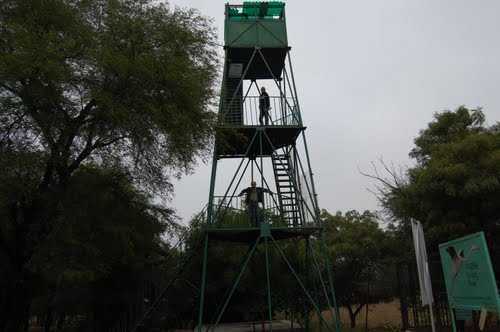
Sultanpur Bird Sanctuary, Gurgaon Overview
Being one of the many weekend
getaways from Delhi, Sultanpur Bird Sanctuary witness a lot of footfall
especially from the people of neighbouring areas of Gurgaon, Faridabad,
Noida and Delhi. It is home to a myriad of migratory birds and is a
great spot for bird watching, especially during winters. It is situated
at a distance of 40 kilometres from Dhaula-Kuan in Delhi on the
Gurgaon-Farukh Nagar Road. There are approximately 250 species of birds
here during the peak season, like in September. During winters, one can
experience an excellent picturesque panorama of various species of
birds. This sanctuary is undoubtedly a paradise for the bird watchers.
 Sultanpur Bird
Sanctuary has been declared as a National park by the Haryana
Government. The government has also initiated various measures for the
development of this area. These measures include construction of mounds,
digging of tube wells and widening of paths, along with improving the
vegetation of the area. It is home to a plethora of resident and
migratory birds. The various species of migratory birds flock here after
covering incredible distances from various parts of Europe, Siberia and
Central Asia. To ease the process of bird watching, there are about
four towers erected at different points of this property. Other
facilities include- parking facilities, toilets, availability of
drinking water.
Sultanpur Bird
Sanctuary has been declared as a National park by the Haryana
Government. The government has also initiated various measures for the
development of this area. These measures include construction of mounds,
digging of tube wells and widening of paths, along with improving the
vegetation of the area. It is home to a plethora of resident and
migratory birds. The various species of migratory birds flock here after
covering incredible distances from various parts of Europe, Siberia and
Central Asia. To ease the process of bird watching, there are about
four towers erected at different points of this property. Other
facilities include- parking facilities, toilets, availability of
drinking water.An educational interpretation centre has also been set up here to offer guidance to the visitors. The tourist complex is also equipped with decent rooms with all basic amenities. Some resident birds are common hopoe, paddyfield pipit, gray francolin, Indian roller, spot-billed duck, great egret; while some migratory birds found here are Siberian cranes, great flamingo, ruff, northern pintail, white wagtail, common greenshank and rosy pelican.
Photos of Sultanpur Bird Sanctuary
Species of Birds at Sultanpur Bird Sanctuary
 Resident birds at
the Sultanpur Bird Sanctuary include the common hoopoe, paddyfield
pipit, purple sunbird, little cormorant, Indian Cormorant, common
spoonbill, gray francolin, black francolin, Indian roller,
white-throated kingfisher, painted stork, black-necked stork, white
ibis, black-headed ibis, little egret, great egret, cattle egret,
crested lark, red-vented bulbul, rose-ringed parakeet, Red-wattled
Lapwing, shikra, Eurasian collared dove, red-collared dove, laughing
dove, spotted owlet, rock pigeon, magpie robin, greater coucal, weaver
bird, bank mynah, common mynah and green bee-eater.
Resident birds at
the Sultanpur Bird Sanctuary include the common hoopoe, paddyfield
pipit, purple sunbird, little cormorant, Indian Cormorant, common
spoonbill, gray francolin, black francolin, Indian roller,
white-throated kingfisher, painted stork, black-necked stork, white
ibis, black-headed ibis, little egret, great egret, cattle egret,
crested lark, red-vented bulbul, rose-ringed parakeet, Red-wattled
Lapwing, shikra, Eurasian collared dove, red-collared dove, laughing
dove, spotted owlet, rock pigeon, magpie robin, greater coucal, weaver
bird, bank mynah, common mynah and green bee-eater.Migratory Birds include Siberian crane, greater flamingo, ruff, black-winged stilt, common teal, common greenshank, northern pintail, yellow wagtail, white wagtail, northern shoveller, rosy pelican, spot-billed pelican, gadwall, wood sandpiper, spotted sandpiper, Eurasian wigeon, black-tailed godwit, spotted redshank, starling, bluethroat and long-billed pipit. In summer about 11 species of migratory birds such as Asian Koel, black-crowned night heron, grey heron, Indian golden oriole, knob-billed duck, blue-cheeked bee-eater, blue-tailed bee-eater and cuckoos also come here.
History of Sultanpur Bird Sanctuary
Sultanpur is named
after Rajput Chauhan Sultan Singh who was the great-grandson of Harsh
Dev Chauhan. Sultanpur was the centre of salt production till the 19th
century. In 1969 at the Conference of the International Union for
Conservation of Nature and Natural resources (IUCN) in New Delhi, the
potential of the Sultanpur Jheel was highlighted. It had been the main
attracting force for birds, since about a century. Peter Jackson of the
IUCN, along with the late Prime Minister of India, Mrs Indira Gandhi was
the main force regarding this.
On April 2, 1971, the Sultanpur Jheel with an area of 1.21 sq. Kilometres was provided with the Sanctuary status under section 8 of the Punjab Wildlife Preservation Act of 1959. Further on 5th July 1991, the status of the park was upgraded to National Park under Section 35 of the Wildlife Protection Act, 1972. Simultaneously the area was increased to 1.42 sq. kilometers. The National Park comprises of the land of Sadhrana, Chandu, Sultanpur and Saidpur villages.
On April 2, 1971, the Sultanpur Jheel with an area of 1.21 sq. Kilometres was provided with the Sanctuary status under section 8 of the Punjab Wildlife Preservation Act of 1959. Further on 5th July 1991, the status of the park was upgraded to National Park under Section 35 of the Wildlife Protection Act, 1972. Simultaneously the area was increased to 1.42 sq. kilometers. The National Park comprises of the land of Sadhrana, Chandu, Sultanpur and Saidpur villages.
Sultanpur Bird Sanctuary Timing
The sanctuary is open on all days of the week, from 7:00 AM to 4:30 PM, except on Tuesday.











